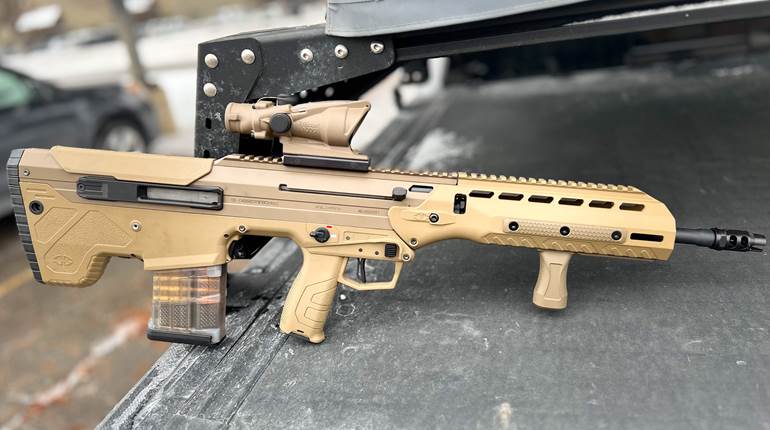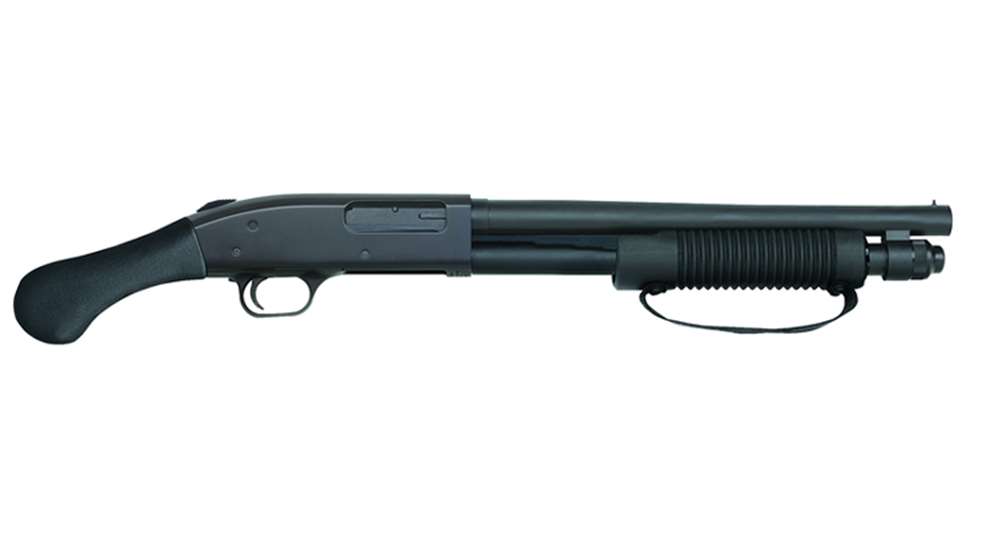
Americans are fascinated with exotic scatterguns of all shapes and sizes, especially those models kept just out of reach by strict federal regulations. We can enjoy watching them in action on the silver screen but buying one is a financially prohibitive proposition. This year, Mossberg has found a way to offer their customers a pump gun with a 14" barrel that can be purchased without the need for a stack of National Firearms Act (NFA) paperwork. It's called the 590 Shockwave, and its one handy little 12 gauge.
The Legalities
While I was testing the Shockwave at the gun range, a few individuals came over to take a look at it. There were plenty of questions about how it was legal to have a 14" barrel 12 gauge in my possession. I am neither a lawyer nor a legal expert, but I'll do my best to give you the same information I shared with the folks at the range:

How firearms are transferred to consumers has to do with a complex set of legal definitions. Some of these definitions focus on a firearm's external dimensions and features. Simply stated, if the gun's feature set fits within a certain set of parameters, the federal government allows it to be sold over the counter at the local sporting goods store when a qualified buyer fills out an ATF Form 4473, passes a NICS background check and pays the transfer fee (additional local and state regulations may apply).

Other guns fall under the auspices of the NFA. NFA-regulated firearms include machine guns, short-barrel rifles (SBR) and short-barrel shotguns (SBS). Taking legal possession of an NFA item involves the purchase of special tax stamps, a healthy stack of ATF mandated paperwork, finger prints, photographs and a long waiting period of six months or more. Once you possess an NFA firearm (if you live in a state that allows them), strict rules must be adhered to in regard to transportation, transfers and storage. All in all, buying an NFA firearm is an expensive and time-consuming hassle.

But which shotguns are considered Short-Barrel Shotguns (SBS)? According to the ATF website, an NFA regulated shotgun is:
(1) a shotgun having a barrel or barrels of less than 18 inches in length;
(2) a weapon made from a shotgun if such weapon as modified has an overall length of less than 26 inches or a barrel or barrels of less than 18 inches in length;
This means a receiver fitted with a shoulder stock and an 18" or longer barrel when it's built at the factory is considered by the ATF to be a “shotgun.”
Shortening a shotgun's barrel to less than 18" changes its legal qualification to Short-Barrel Shotgun, making it an NFA-regulated item that requires a $200 tax stamp and all of that lovely ATF paperwork. If a shotgun's shoulder stock is removed and replaced with a pistol grip resulting in an overall length less than 26" (even if the barrel is 18" or longer) the shotgun's legal status changes to Any Other Weapon (AOW). An AOW requires a $5 tax stamp instead of a $200 stamp, but the paperwork and process remain the same.
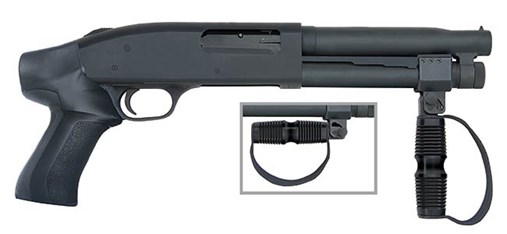
How then does the Mossberg 590 Shockwave, with its 14" barrel, qualify as a non-NFA item? Due to the manufacturing process used to build the gun, it doesn't fall under the prevue of NFA regulations. Instead, the definitions that apply are found in the Gun Control Act of 1968 (GCA). Under these regulations the Shockwave is legally considered a “firearm,” not a shotgun.
If, at the factory, a brand-new receiver is fitted with a pistol grip first instead of a shoulder stock, it's considered a Pistol Grip Only (PGO) firearm. If the overall length of that firearm, with the pistol grip and barrel installed, is greater than 26", then the barrel can legally be shorter than 18". In the case of the 14" barrel Mossberg 590 Shockwave, the Raptor bird's head grip gives the gun an overall length of 26.32". That makes it a firearm.

The key to enjoying a firearm like the Shockwave is to keep a few more things in mind. Although the federal government says it's a gun that can be purchased by qualified buyers over the age of 18, some states have regulations in place banning it and other guns like it. As always, check your local regulations before ordering one.
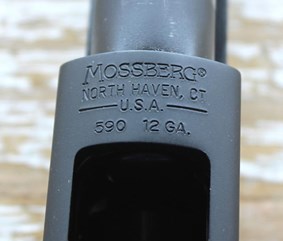
Remember that this gun's legally defined firearm status is wholly dependent on its external dimensions and features. If you make modifications to the gun, including the addition of a shoulder stock or reduction of its overall length to less than 26", you're back in NFA territory. Once you own a Shockwave, don't monkey with it unless you complete the required NFA paperwork first.
Firearm Features
The Mossberg Shockwave is a variation of the company's 590 tactical shotgun intended for military and law enforcement applications. In fact, the Shockwave configuration is inspired by what's been informally known as the “witness protection” scattergun used by some agents in the field.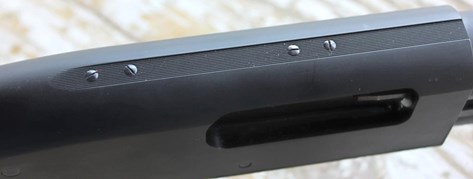
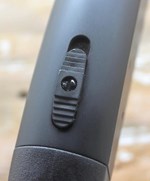
Although the Shockwave's barrel and grip are shorter, the rest of the gun is comprised of reliable 590 standard components. Features include a heavy-walled barrel, right- and left-side action bars, a drilled and tapped aluminum receiver, a sliding tang-mounted safety, and polymer trigger housing. The 590 models differ from the 500s in that the barrel support slides around the barrel and is secured by a removable magazine cap. Removing the cap allows the barrel to be removed from the receiver and provides access to the magazine spring and follower for easy cleaning or replacement.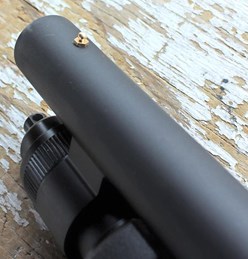
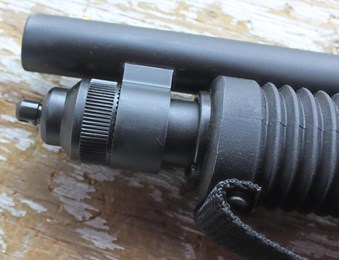
The barrel is topped with a brass-bead front sight, and the magazine cap is fitted with a sling swivel stud. Some folks may question the addition of a brass-bead front sight to a gun they plan to shoot from the hip, but others appreciate having the option in place. The ribbed polymer fore-end (with hand strap) and the smooth Raptor bird's head grip are both manufactured by Shockwave Technologies. Although there’s no sling swivel stud attached to the grip of the gun I worked with, studs will be added at the factory to support two-point slings.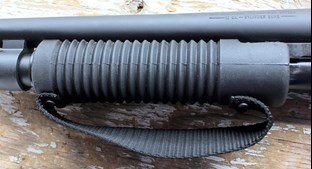
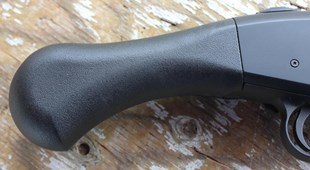
An advantage of installing a 14" barrel is the preservation of the 590's standard magazine capacity. The ultra-compact NFA short-barrel shotguns, like the 6.5" barrel Surbu Supper Shorty, can only hold 2+1 rounds. The Shockwave's capacity is 5+1 when loading 2 3/4" shells. Loading 3" shells drops the capacity to 4+1, while using 1 3/4 " long Aguila Ammunition Mini Shells increases the capacity to 8+1. These numbers are based on what I could stuff into the magazine in the course of testing.
Some readers may question the veracity of using the Aguila Mini Shells for self-defense. Although these shells ignite properly and have the advantage of taking up less space in the magazine tube, they also have a reputation for poor feeding. 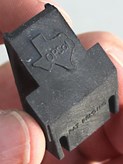
The Mossberg team introduced me to a slick little accessory called the OPSol Mini-Clip, which neatly solves the Mini Shells feeding issues. It's a wedge-shaped rubber block that's manually pressed into the open slot at the grip end of the 590 receiver, no tools required. When you're ready to shoot standard length shells, just press the Mini Clip back out.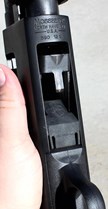
The Mini-Clip acts as a buffer to position the Mini Shells in just the right spot to chamber properly as they move from the magazine to the elevator assembly. This device works perfectly and can be purchased online for $15. The Mini Clip is compatible with Mossberg 500, 590, 590A1 and Maverick 88 models.
Hip-Level vs. Eye-Level Aiming
Much like the AR-15 pistol, there’s not much in the way of formal training resources or live-fire classes to teach individuals how to use a compact, bird's-head gripped 12 gauge as a defensive tool. You'll just have to muddle through figuring out what works best for you.
That being said, two schools of thought tend to take the lead with this type of firearm: hip-level and eye-level aiming. Hip shooting is just what it sounds like. Take a firm stance, lock the shooting hand against your hip, point the gun forward with the support hand and pivot your torso like a tank turret to aim. Hip shooting has the advantages of providing a firm, reliable grip for the operator and an unobstructed view of one's surroundings.
However, shooting from the hip requires a good deal of practice to master, much more than some folks might be willing to invest in. Thanks to the relatively straight shape of the Shockwave's grip and the strap attached to the fore-end, the felt recoil generated by standard velocity and reduced-recoil shells is surprisingly manageable from the hip. This makes it more likely that Shockwave owners will practice on a regular basis. Nevertheless, hip shooting is a short-range solution best reserved for across-the-room and across-the-house distances (15 yards or less).
The other option is to bring the pump gun up to (or near to) eye level to sight along the top of the barrel or use the front bead sight. Visually, an eye-level view will feel more familiar, but this method is potentially dangerous to the operator. Holding a hard kicking 12 gauge at eye level with an improper grip will allow the recoil to drive the grip or receiver directly into the operator's face causing serious injury should one’s grip slip.
Straight up-and-down pistol grips make mastering eye-level shooting easier because the operator can lock in the wrist of the shooting hand properly. The bird's head grip of the Shockwave causes the wrist to bend at an awkward angle when the gun is held this high. I’m not going to recommend shooting this gun at eye level, but if you choose to do so, start at the hip and work your way up slowly using low recoil ammunition until you get the hang of it. Do not keep shooting if you're tired or distracted unless you’re looking forward to a long conversation with your local maxillofacial surgeon.
Personally, the highest hold I felt comfortable using with the Shockwave was what I'll call a “pec press.” I lifted the grip up alongside of the ribcage, leveled off when I reached my armpit and then pressed it forward about 8" in front of the pectoral muscle on my shooting-hand side. From this position the gun's recoil drives the grip back towards the air gap in between the rib cage and bicep, just in case the grip should slip.
Is this a bonafide tactical technique? I have no way of knowing at this point, it's just what feels right to me so far. A problem with the homemade pec press approach (it can clearly be seen on the shot pattern targets I've included in the next section) was a tendency to hit high on the target instead of center mass. I think I’m subconsciously lifting the support hand up just a little bit more so that the brass-bead sight is in my line of vision instead of just below it. It's a habit I'll have to break with more practice unless I move on to a different technique.
Ammunition Selection
At the shooting range the Shockwave ran flawlessly. All of the controls worked as intended and all of the test ammunition fed and fired without any malfunctions. The trigger exhibited a 6-lb. 9-oz. trigger pull with a distinctive trigger reset.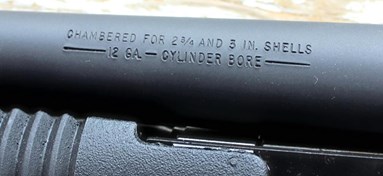
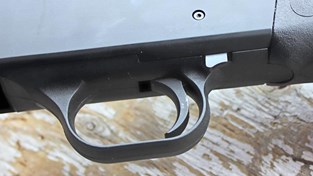
Once I was (mostly) hitting what I was aiming at from a distance of 7 yards, it was time to see how various loads patterned from the Shockwave's 14" cylinder-bore barrel using Birchwood Casey Shoot-N-C 12" x 18" silhouette targets to capture the results. The general rule-of-thumb is that one can expect about 1" of shot pattern expansion for each yard of distance the shot load travels. I've seen this rule work fairly well with 18" cylinder bore 12-ga. guns but this barrel's patterns were more diverse.
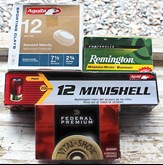
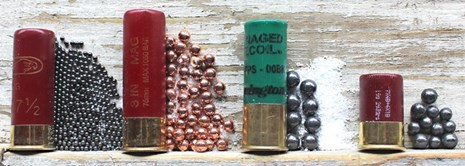
First up was the Aguila Ammunition's low-brass 2 3/4" Sporting Clays load filled with 1 1/8 oz. of #7 1/2 lead birdshot with a listed velocity of 1225 fps. The recoil was moderate by 12-ga. standards with a dense pattern that opened up to 10".
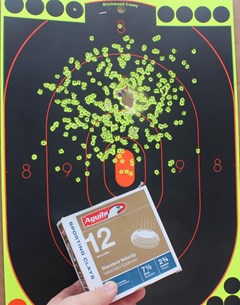
It seemed the test wouldn't be complete without at least one 3" load, so I loaded up a particularly potent Vital Shok 3" high-brass Magnum shell manufactured by Federal Premium. This round shoves 41 pellets of buffered copper-plated #4 Buckshot at a listed velocity of 1100 fps. The felt recoil was, well, educational. Let's just say I'm going to reserve this load for shoulder-stocked shotguns in the future. The pattern was a high-on-the-target 8" in diameter.
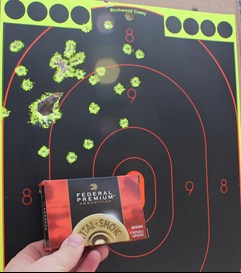
Moving on to a reduced recoil buckshot load seemed like a good idea at this point. Remington's high-brass Managed-Recoil Buckshot load launches eight pellets of buffered lead 00 buckshot at a listed velocity of 1200 fps. The pellets formed a ragged hole about 3" in size. Felt recoil was just a bit lighter than that of the heavy birdshot load.
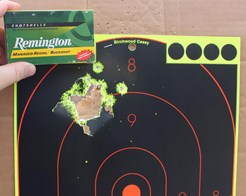
The last shell patterned was the unique 1 3/4" long high-brass Aguila Mini Shell buckshot load. Don't let the size fool you. This short shell is packed with seven pellets of #4 buckshot and four pellets of #1 buckshot for a total of 1 oz. of lead shot that scoots right along at a respectable listed velocity of 1200 fps. It printed a 4" pattern and also produced the lowest level of felt recoil of the shells tested.
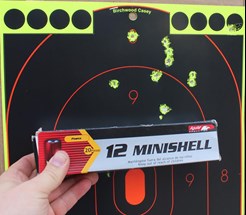
Parting Thoughts
The new Mossberg non-NFA 590 Shockwave 12-ga. pump-action has already garnered all kinds of attention from the shooting media and consumers alike. But is this gun a handy defensive option or an exceptionally cool range toy? I'm happy to report that it's both.
There's no doubt the Shockwave satisfies that Hollywood movie gun itch oh-so-well with its 14" barrel, Raptor grip and strapped fore-end. I couldn't resist tucking it into a Voodoo Tactical scabbard loaded with Molle straps and elastic shot shell loops to complete the movie gun package. I've wanted to get my hands on a 12 gauge like this for a very long time and it proved to be a real hoot to shoot.
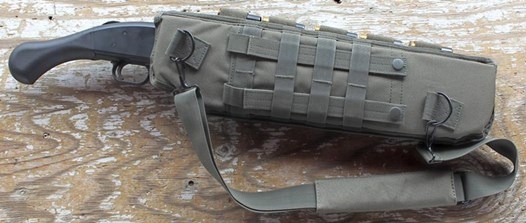
Once the novelty wears off, what consumers will be left with is a rock solid, utterly reliable Mossberg 590 firearm with a military and law enforcement heritage that is readily apparent in its design. From a mechanical stand point, this gun definitely has what it takes to go to work as a defensive tool if the owner is willing to do the work necessary to master it.
Despite all of its other positive attributes, the Shockwave’s best feature has to be its price tag. NFA-regulated short-barrel shotguns often cost around $1,000 on top of the $200 tax stamp and transfer fees. Black Aces Tactical offers a custom box-magazine fed pump that's considered a firearm too, but it will set you back $1,299 to buy one despite it's tax-stamp free status.
Even though the good folks at Mossberg knew they could charge more for what was obviously going to be a hot-ticket item, they've launched the Shockwave with a suggested retail price of $455, which is on par with other pistol-gripped guns in their catalog. Once things settle down a bit, real-world prices should move closer to $399. No matter your reasons for wanting to work with the Shockwave, you can afford to give it a try.

Specifications
Manufacturer: Mossberg
Model: 590 Shockwave (#50659)
Action: Pump Action
Caliber: 12 gauge
Barrel: Matte Blue Steel, Heavy-Walled
Receiver: Hard Anodized Aluminum
Trigger Guard: Black Polymer
Forend: Shockwave Technologies Raptor Strap Kit, Ribbed Black Polymer
Grip: Shockwave Technologies Raptor Bird’s Head, Smooth Black Polymer
Sight: Brass Bead
Barrel Length: 14" Smooth Bore
Choke: Cylinder Bore
Overall Length: 26.32"
Trigger Pull: 6 lbs. 9 oz
Weight: 5 lbs. 6 oz. Unloaded
Capacity: 3" Shells = 4+1, 2 3/4" Shells = 5+1, 1 3/4” Aguila Mini Shells 8+1
Accessories: Lock, Owner's Manual
MSRP: $455
Feeding Accessory: OPSol Mini-Clip $15
Shotgun Scabbard: Voodoo Tactical Breacher's Shotgun Scabbard (20-8916) $29.95

































